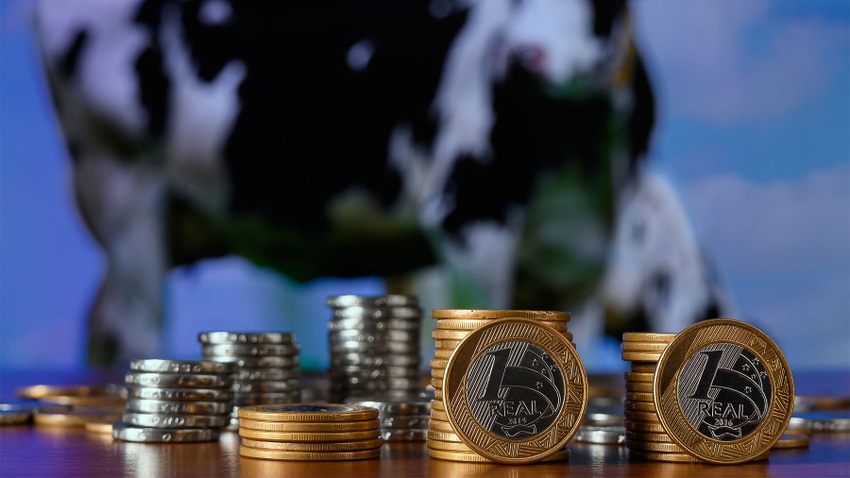
If a recent dairy outlook webinar put on by Farm Credit East was any indication, then this year’s dairy outlook can be summed up with one word: mixed.
USDA is forecasting an average all-milk price of $20 per cwt, which is right in line with last year. But that’s still $5 per cwt lower than two years ago.
Exports now make up 18% of U.S. dairy production, but there are a lot of things happening in the world that could affect the amount of milk products other countries buy from U.S. dairy farmers.
And butter and cheese stocks in storage are up, even though dairy production has remained flat the past couple of years. So, dairy farmers are producing more than ever without having to drastically increase herd numbers, but with more cheese production coming on line and questions over exports, will there be enough domestic demand to eat up the supply?
Chris Wolf, professor of agricultural economics at Cornell University, says producers should keep an eye on these five things he believes will have the biggest impact on the dairy industry this year:
1. Feed prices. Commodity prices are down, which is good news for dairy producers and livestock producers in general. There was a huge carryout of corn last year — 2.1 billion bushels, a rise of 10 million bushels from the year before — and the largest soybean carryout since 2020-21 at 315 million bushels.
While most dairy producers grow their own corn and soybeans, Wolf says these prices are a useful benchmark for opportunity costs on soybeans and corn.
"If you do have to buy something, $20 milk and $4 corn, or $4.50 corn or even $4.75 corn, is a whole lot different than $6.25 or $6.50 corn,” he says. “Other feed prices tend to come along. Forages are a lot cheaper this year, at least in this part of the country, than they were last year. So, I think feed prices is a big one.”
2. Beef prices. This has to do with the incentive to cull, and where the breakeven is relative to a producers’ profit margin versus when you have some cows that are getting far out.
It’s no secret that beef prices are higher, largely driven by the smallest beef herd in 73 years. The average cow slaughter price in November was $104 per cwt, over $20 per cwt higher than the year before.
Related to this, Wolf says, are heifer numbers. There is a lot of talk right now about how it is the smallest number of dairy heifers in 20 years. According to CoBank, dairy replacements over the past six years have dropped 15%, or 709,100 head, largely because of higher rearing costs and lower prices.
And while this is significant, Wolf says he is not convinced that it is that big of a deal.
"The repro programs are so efficient today, we just don't need as many replacement heifers as we used to," he says.
What is a big deal, though, is the proliferation of the beef-on-dairy market. Beef semen sales have grown from 2.5 million units sold in 2017 to 9 million units sold in 2021, according to data from Cornell. At the same time, dairy semen units have dropped from 23.19 million units in 2017 to 16.1 million units sold in 2021.
"I'm talking to guys, and you look at the price of the bull calves, if they're beef crosses, it's been enough to really matter on the bottom lines for a lot of producers," Wolf says.
"I think that it's really more about the cull calf prices and how low the beef herd is, but we're probably going to continue to use the beef-on-dairy, and that probably makes the beef guys less happy," he adds.
3. International milk production. The widespread farmer protests in Europe, driven by anger over environmental regulations and proposals to get rid of a significant number of cows, has gotten a lot of attention in the past few weeks.
Wolf says the question for dairy is, will the European Union and New Zealand roll back efforts to cut cow numbers? And if so, will this present an opportunity for more U.S. dairy exports?
"That's a big one because to the extent that they cut back, or even hold flat again, then the growth opportunities are going to be for U.S. products," he says. "And we are going to need to export more cheese, which we can."
4. Exports. Related to international milk production is the ability to export products.
Exports have become a significant part of the dairy industry. According to data from Farm Credit East, U.S. dairy exports set a record of 5.27 billion pounds in 2022, and dairy exports now account for about 18% of U.S. milk production.
While inflation has been a problem in the U.S., Wolf says it has been much more of a problem in other developed countries. “So, the question becomes, can we maintain the export demand to some of these countries given the strength of the dollar and how bad inflation has been in some of these places?” he asks.
Some countries to watch are Canada, Japan and the country’s most important dairy export country, Mexico.
“Part of the deal is, because we’ve recovered better, the dollar is really strong,” Wolf says. “Even if prices are better here, it is still more expensive for other countries.”
5. Domestic milk production. Wolf says this goes hand in hand with more processing that is scheduled to come online and whether co-op base programs will be relaxed.
"Some of the margins for the second half would suggest that we see some milk production response,” he says. “We've had two years of flat production. USDA is projecting a small increase, a little bit less than 1% this year. But there is strong demand, especially domestically."
Read more about:
MilkAbout the Author(s)
You May Also Like






